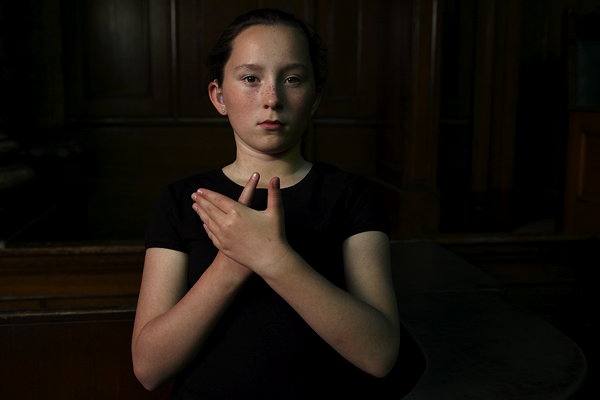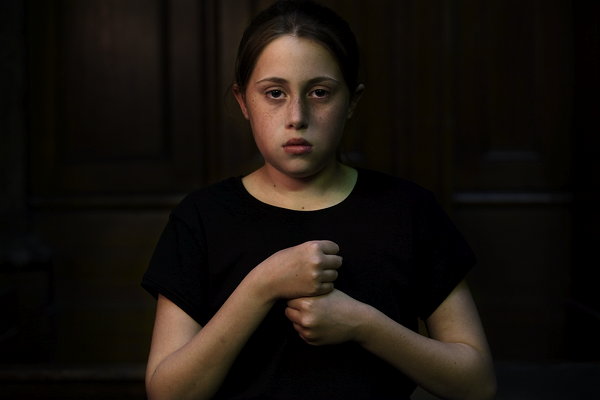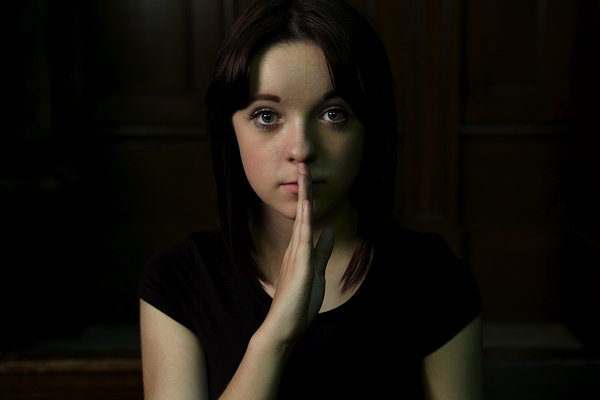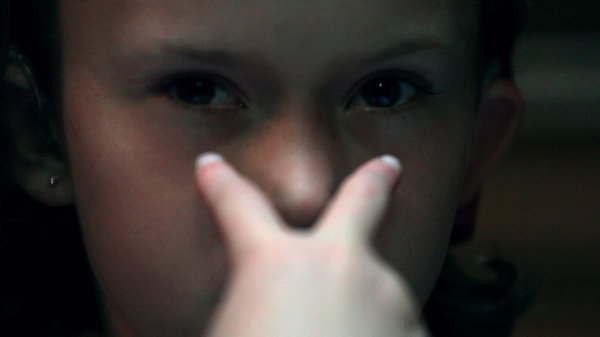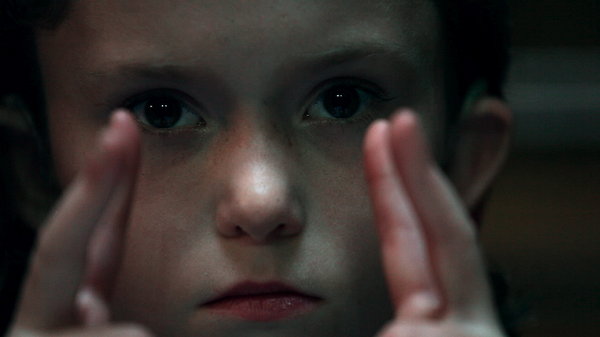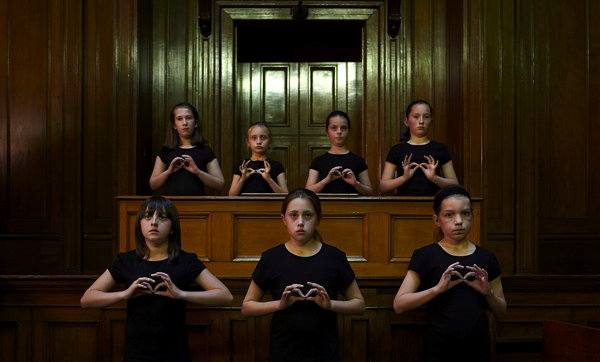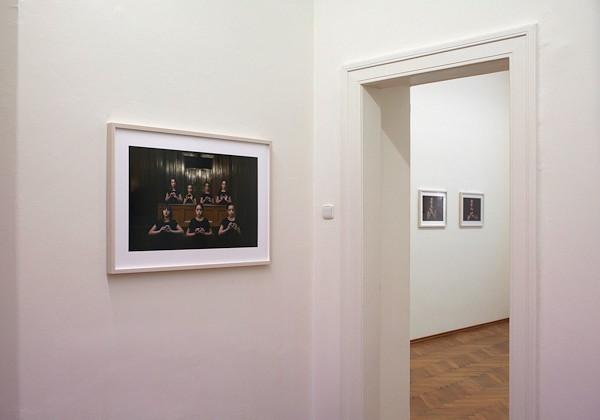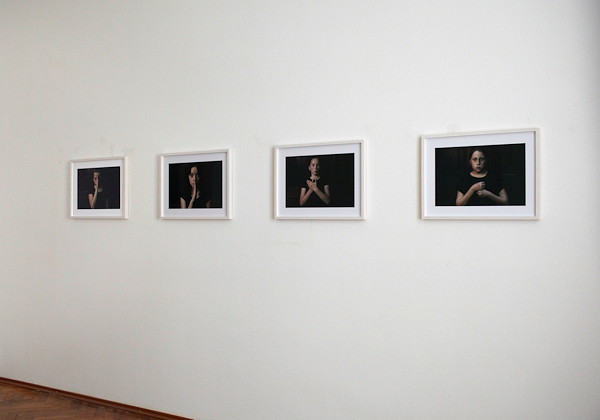Danica Dakić
Bratislava
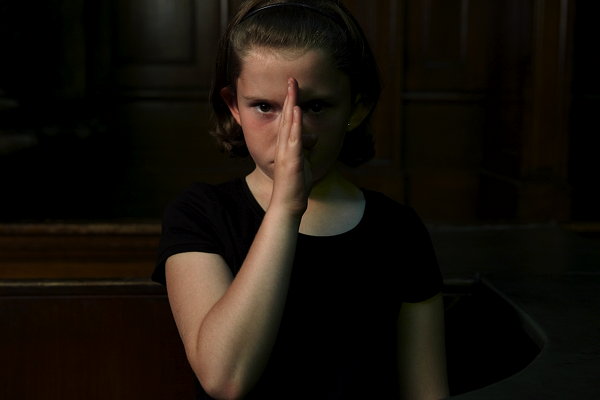
DANICA DAKIC
Emily
Exhibition: Septembre 28 - November 26, 2011
Emily: or, On Education
They sound like commands, never mind that the voice of the woman uttering them is soft and, with its Northern dialect, slightly endearing. “Cry!” “Look at me!” “Concentrate!” “Remember!” “Relax your hands now!” And then: “That’s a good girl!” and “Well done, Emily! Well done!”
Her voice is the only one we hear in the video; it is exclusive. The woman’s voice spreads over the surface of the image, an image that shows one thing and one thing only: the face of a young girl in close up, reacting to, no – corresponding with the woman’s voice. When God said, “Let there be light,” there was light, and when the woman says, “concentrate,” the girl concentrates.
The girl does as the woman commands. But she does not cry. Why doesn’t she cry? Because we err when we perceive the women’s utterances to be commands. Most of them are in fact something else. They are words. (When commands do enter the woman’s speech, they are subtle. Sublimated to a teacher-pupil setting, which is in many ways a sublimation in itself...)
In the beginning was the Word, and the Word was with Her, and the Word was Her. Then She spoke. She speaks and she delivers the words, the gospel, to her pupil. “Cry,” she says, and though we do not see her, as she is only voice and thus her voice resounds all the more powerfully, we understand that she is giving these words to
the girl. “Cry,” she says and she bestows the word upon the girl, who takes it up, avails herself of it, and exercises it. The word is sounded, no – signed, utilized, stretched, not quite consumed.
This is the setting. This is the story. There is no story beyond the setting. Obviously, the video must start somewhere. And equally come to an end. Thereby creating a narrative by default, since at its structural core, this is all a narrative consists of: The points A and B, and that moves from one to the other.
Point A and B are marked by beginning and end titles. They are thus delineated from the abyss of non-meaning by the ultimate cause of being, that of the artist. Yet within these extrinsic boundaries, little development can be detected. Somewhere, the story sets in. “Cry,“ says the woman. She might very well have said: “Concentrate!“
The ending is a different matter, for sure. The coach has finished her instructions, “Thank you, Emily!” Thus dismissed, the girl leaves the frame. Emptiness prevails just long enough for us to realize that this is over. The end of story and video coincide. But we are forced to perceive this concurrence as mere convenience. It owes to the fact that the material is culled from a real-life event. (This is no documentary though, just a situation where reality is leaned on.) In what I would like to call a lucky accident, the opportunity for a narrative end presented itself. And the artist seized her chance.
If there is no story beyond the setting, no narrative development beyond the end, and if beginning and end add up to an arbitrary slice of life, can it be said that there is form? Is the artist reigning supreme upon her material, declaring it art in a capricious or autocratic (or conceptual) act? Yes and no. Yes, there is form. And no, this is made art not by definition, but through the aesthetics of perception. Moreover, in this video, form follows perception. And it is through perception that the artist introduces the viewer to the work. In fact, she places the viewer smack, dab in the middle of it.
Let’s think about duration for a moment. (How long is a moment?) If the length of the video is not determined by narrative – one might say, the video starts four and a half minutes before its end – nor by a random gesture, what has governed the decision for this (and not another) time span? Why does the plot start at “Cry!”, and not “Concentrate!“? An answer: Four and a half minutes is the time we need to look, to hear, to understand. And to wonder.
First and foremost, we wonder about the girl. About that which we are given to see. The obvious facts are established quickly. First, we comprehend that she is signing. Then we discover her hearing aids. We grasp that she is being taught. Though it remains unclear – at least to those of us who have no knowledge of sign languages – whether she is learning basics or subtleties. Is every deaf child taught this way? Or could it be that she’s acquiring a special skill?
The camera is close, very close, cropping the face even, allowing us a discomforting intimacy. We might believe our unease to be stemming from the fact that the face is transfixed by the framing. Is the camera illicitly intruding upon the child? Are we treading where no adult should go? Yet it is we who are pinned in place, in a position simulating voyeurism. Our chagrin is not caused by conscience, nor by respect towards another being. It springs from our lack of control over our own gaze. This lack stands in stark contrast to voyeuristic pleasure. Because the latter hinges upon the fantasy of free will and intentionality.
We have four and a half minutes. Enough time to become aware of our own drive to register, process, analyze. Not enough time for closure. The unease abates slightly once we realize that the girl is quite intentional and active in what she is doing. Her blank face had originally fooled us. This isn’t the first time that the absence of psyche in physiognomy been mistaken for purity and vulnerability. We do this to children time and again, zoom in on their putative innocence. In fact, there is a want of echos in this face. Of traces that might be read as expressions of an individual. And this creates a conflict, since it is expressiveness that this face is asked to convey. Signing, more than other forms of speaking, demands a strong use of mimicry.
“Sad,” cues the woman’s voice. And though we do not see her, this unseen source of language and meaning, we see her in the girl. For the girl is her mirror. The woman is obviously feeding her morsels of knowledge by enunciation and by gesture. The girl takes all in. And regurgitates simultaneously. Observation/Imitation. In this, she is fully focused, indeed her concentration astonishes. A trance. She shares with us no sense of awareness of the camera, despite the fact that she is looking almost directly at it. Towards the end, the spell is broken. Her eyes slip away, as if in need of another object of interest. It is those moments, when she allows herself to break her role, that her self steals into her face, fleetingly.
The girl applies herself to the task at hand with determination. Obviously, she is a willing subject to subjection. And does not need Louis Althusser to understand the element of repression in language and subjecthood. Pupil and teacher seem complicit with each other in this act. Are they complicit with the camera, the artist-eye?
I can find no evidence of such a collusion. To the contrary. I would suggest that it is in vain – all speculation upon cast of mind of those cast in their roles by the camera. The psychology we perceive is a trick. An effect of the medium. And of our desire too. We are imprinting upon the face, upon what we see, as the voice of the woman might be imprinting upon the girl (for all we know), according to our prior experience of a particular human relation called Erziehung – education or upbringing. Youth and adult, subject formation and pedagogy, compliance and command – it is an ancient pairing. Pre-dating this story, pre-dating us.
Yet the video leads us, willing subjects, into the trap of psyche and reflection. It does so with the tools of its trade, a counter-positioning of image and sound. The image is quite flat. But its cropping puts it right up to us. It is felt almost viscerally. Intruding upon our personal space, it fixes us in proximity and holds us there. Rejection of the visual experience would be the only possible route of escape. Shut my eyes - leave the room - I do not want to see another arty-farty video. Let’s assume rejection is out of the question. That leaves us in the stranglehold, in the face of the girl. How far away are we? Close. No, even closer.
The woman’s voice must be coming from behind us. It is only logical. What we would expect, sitting that close, facing the girl. Her voice, the woman’s voice never ceases. It is not loud, but its timbre carries far. Despite all this intimacy, we must be sitting in a large room. A private scene in a public setting? No matter, in any case there is something off with this situation. This soft, friendly voice (larger than life), extending its reach in space and time, is omnipotent in another way. Where it reigns, all other sound has been suspended. No shuffling of the feet. No sniffing of the nose. No scratching of the hair. The girl’s eyes blink rapidly in silence.
If it is the voice that makes the space, and in her three-dimensionality determines place, then it is she that truly casts us into the scene. It is she who encourages us to take the face of the girl not as an image, but for real. Simple logic, isn’t it? The space is there, and we are in it, together with the voice. The voice is mirrored in the girl’s face and vice versa (we presume), and so it must exist. Despite its flatness. We see, and hear, ergo we exist. Pardon? Did I not mean: “Ergo, it exists?“
This is what the video shows us. The confusion, which is really no confusion at all. It ensues in the collision of actual sensory perceptions with our concept of perception. This is what we know: That bodily boundaries are whimsical. That our belief in bodily and mental autonomy is just that, a belief. But we don’t want to know this. We do not want to know that our subjectivity is the effect of a fantasmatic effort. That it is contingent. Dependent on a laborious process of construction. One in which our own psyche coalesces in complicity with others.
Propelled into the scene, unsure of our footing, present but without a place, we are made to realize not just in theory, but rather quite practically that our existence is rooted in the ability to forge connections with others. We might be looking directly at the girl’s face, as if looking at our mirror image. But she knows what we seem to have forgotten. That in order to come into being, one must first and foremost reach someone else.
And be reached in turn. So the teacher and pupil mirror each other in their attempt at communication. So the camera joins them in their game. So we too are included in their complicity. The artist acknowledges her part in this complicity by highlighting the girl’s name. Emily. A person. A subject.
Nonetheless, complicity is a far cry from symbiosis. Despite the mirage of unity, the simultaneity of utterances, the incessant drive for identification on a multiplicity of levels, we can all fall apart. What holds us together is the recognition that this work of concentration must be done. That it is not centered on us, though we are in its center (The blind spot/the eye of the hurricane). We are but a medium of the artist. Nevertheless, this experience will make an imprint upon us, change us, help us be.
The consequence of having been put in the uneasy, in-between position is ethics. Maybe, maybe, if we manage to think away from ourselves and towards connecting with others, we can take pleasure in the dissolution of the antithesis between concentration and dispersal. For really, what is concentration but a dispersal of the ego. And how else would we come into existence if not through the shared experience of becoming and becoming undone.
In deliberately situating us in her work without giving us the means for representation, Danica Dakić has acknowledged that a blind spot exists. But if, in the center of meaning making, there can be found an instance that cannot be represented – moreover, if we find ourselves in that exact location, then who is making the meaning? It follows that there is no voice of God, nor autocratic authorship. Any meaning worth its salt – that is, any work that matters to its viewers – must take a risk. The risk of being shattered from the inside. In this, subjects are not so different from artworks.
Ruth Noack, 2011
*Ruth Noack, born in 1964, a curator and writer, studied feminist theory, audiovisual media and art. In 1999 she gained her degree in art history from the University of Vienna with a dissertation on a feminist topic. From 2002 to 2003 she was president of the Austrian section of the AICA (International Association of Art Critics), and in 2006 and 2008 she was a member of the jury for the CCAA (Chinese Contemporary Art Award). She has co/curated numerous exhibitions amongst many “Szenen einer Theorie” (Scenes of a Theory, 1995), “Dinge, die wir nicht verstehen” (Things we don’t understand, 2000). A series of exhibitions under the heading of “Die Regierung/The Government” (in collaboration with Roger M. Buergel.). From 2005 to 2007 Noack held the post of curator of documenta 12. Noack’s numerous publications and lectures include texts on the work of Eva Hesse, Alejandra Riera, Mary Kelly, Ines Doujak and Danica Dakić
